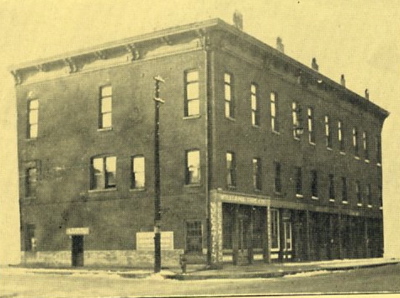Encyclopedia Dubuque
"Encyclopedia Dubuque is the online authority for all things Dubuque, written by the people who know the city best.”
Marshall Cohen—researcher and producer, CNN
Affiliated with the Local History Network of the State Historical Society of Iowa, and the Iowa Museum Association.
JULIEN THEATER BUILDING (MASONIC HALL)
JULIEN THEATER BUILDING (MASONIC HALL). The Julien Theater, built in 1856 by McKinley & Poor at a cost of $17,000, stood at Locust and Fifth. (1) The auditorium was 50 by 75 feet and was able to accommodate an audience of four hundred. The cramped space and poor ventilation, however, often caused patrons to hold their noses or gasp for breath. (2) The first and second floors were devoted to lawyers' offices.
Theatrical managers in the early days hired actors, rented a theater and produced as many plays as they could. These "stock companies" did not often change, but the leading actors were frequently changed with actors who had gained fame in the East. Stock players had to learn new parts with little advance notice. Occasionally five or six players were rehearsed at one time.
Sentimental melodramas were the most popular. Also common were historical plays involving Indian wars, political campaigns, and famous men.
The Julien Theater outlived the PEOPLE'S THEATER but was surpassed by the ATHENAEUM.
In 1870, the building was remodeled and used by the YOUNG MEN'S LIBRARY ASSOCIATION, DUBUQUE AND SIOUX CITY RAILROAD, ILLINOIS CENTRAL RAILROAD and other corporations for offices. The upper floor, the theater, was used by the Masonic organization.
---
Source:
1. Oldt, Franklin T. History of Dubuque County, Iowa. http://www.ebooksread.com/authors-eng/franklin-t-oldt/history-of-dubuque-county-iowa-being-a-general-survey-of-dubuque-county-histor-tdl/page-19-history-of-dubuque-county-iowa-being-a-general-survey-of-dubuque-county-histor-tdl.shtml
2. "Shakespeare Battles 'Slave of Love,'" Telegraph Herald, September 11, 1960, Dubuque News, p. 1 The Julien Theater Building was located at the corner of Locust and Fifth STREETS. Built in 1856 by Smith, Kinley & Poor, it was 100 feet long, 50 feet wide, and three stories high.
3. Briggs, John Ely, "Exploring the History of Iowa," Cedar Rapids Gazette, 1936
See: MASONIC TEMPLE


